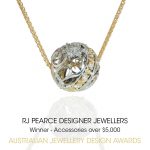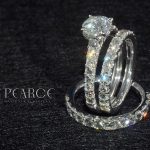by Helen Collier
Benjamin Franklin asserted that there are no certainties in life, except death and taxes, but a group of Australian jewellery makers (Fellows of the Gold & Silversmiths Guild of Australia) wish to add a third guarantee to his list – their maker’s mark. Everyone loves a guarantee when making a precious purchase, it gives assurance that we are buying a genuine article, and paying the correct amount for the true value of our item. Hallmarks have been giving that guarantee in England since the 1300s, and in line with that time honoured tradition, members of the Gold & Silversmiths Guild of Australia mark their work out of personal pride as well as for customer confidence. When investing in a piece of hand made Australian jewellery, there’s a piece of mind that comes with the integrity bestowed by a maker’s mark and a guild mark.
Each country has its own system of marking precious metals; from none at all, to full legal obligation. In England it’s a legal requirement that every gold or silver item of jewellery made or sold has to be assayed (assessed for its purity) by the assay office and then marked accordingly by them – pieces that don’t reach the standard can be destroyed. Without such governance here in Australia, the customer looking to buy a beautiful piece of Australian made and designed jewellery finds themselves at a disadvantage. Unless of course they buy a piece marked with the Gold & Silversmiths Guild of Australia’s seal of approval. In an otherwise unregulated environment, the Guild’s marks become all the more valuable to the jewellery buyer, as they show a willingness on the part of the jeweller to give every assurance that their piece is sound, of standard of excellence and meets the Australian Standard for precious metals.
In addition to symbolising fine craftsmanship, the Guild marks on a piece of jewellery (see photo), details from left to right who made it, from what precious metal, that it is Australian made and whether by a Fellow or Full Member. It’s mark of surety, provenance, craftsmanship and history.
A jeweller seeking acceptance into the Gold & Silversmiths Guild of Australia, submits a number of pieces of their work for assessment by seven experienced jewellery makers who make up the National Council of the Guild. After detailed assessment of their work and following up four sets of references, if voted in, the jeweller pays their annual subscription to become a member of the Guild. The Guild have their Fellow’s ‘punch’ made up for them, (it is illegal to have the punch made by any other means) and the jeweller sends their maker’s mark to the Guild so it can be recorded by the Keeper of the Punches who strikes their mark on a silver plate. The jeweller is then sent their kangaroo head punch and a date punch. Each metal purity also has its own specific punch so a jeweller buys a set.
Then at the start of each year on 1st January, a new date punch is produced which can be purchased by Guild members. From this collection of punches, the relevant ones are struck into a piece of jewellery as it is being made (struck into the shank of a ring or tiny plate on a necklace fastener).
Just because a jewellery maker is a Fellow of the Guild doesn’t follow that he or she will mark every piece of jewellery they make. It is not a legally enforced requirement for a jeweller to mark his or her work, or be a fellow of the Guild, so to make your buying process harder, there are some beautiful pieces of jewellery being made in Australia that won’t carry these marks. All pieces made and designed by a Fellow of the Guild will always have a millesimal purity mark (in accordance with the Australian Standard 2140-2008), integral to the piece, it won’t be something that can be easily removed. If the piece contains more than one metal alloy, it will be marked in order of content. But unless it’s marked as such, there are no guarantees that you are buying genuine silver or gold.
The integrity of a piece of jewellery is dependant on its make up and the quality of the precious metal alloy. Alarming stories abound of ‘sterling silver’ rings that melt or fail during repairs and turn out to have an outer coating that simply falls off. Aside from not being worth the money you have paid for them, inferior metals can cause skin discolouration and irritation. If you’ve been sold sterling silver or 18 – 22 carat gold, you don’t expect to come out in a rash due to a high nickel content.
The benefits of a Guild mark and maker’s mark in your jewellery are many and benefit all concerned. The Guild mark and date mark are useful historically to determine when a piece was made which can help with valuations, and indeed with police investigations by identifying jewellery that has been stolen and reuniting it with its rightful owner. Knowing it’s Australian, eradicates the issues that come with cheaper imported goods.
Our buying power has increased exponentially in the last few decades and we the consumer dictate what we find acceptable. People shopping with a conscience, who understand the harm that plastic creates, have pressurised shops to withdraw it. When we buy food we check the label, seeking reassurance as to our food’s integrity – and jewellery is no different – when customers start to ask their jeweller if they are a Guild member and whether they mark their work with a kangaroo head, they will start to drive the demand for a mark. It will effectively dictate the future of Guild marking in Australian-made jewellery.
It’s astonishing that something so small can pack such a punch (at 1.25mm the details of the marks cannot be gleaned without magnification), but in the case of these punches, they do exactly that. As Tim Peel, current President of the Guild said ‘There aren’t many punches you go looking for in life; for me these are the only kind worth having and where everyone benefits!’





